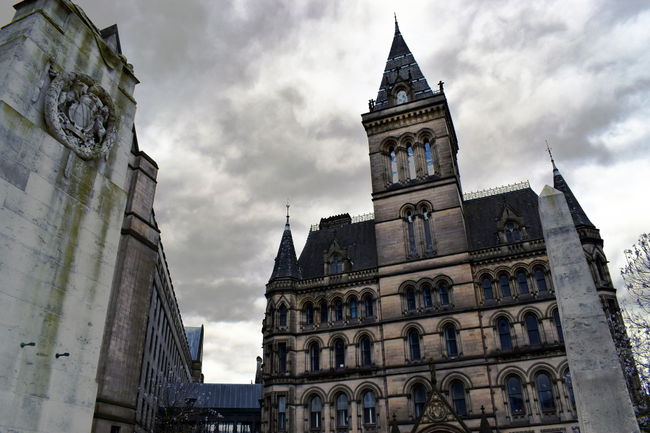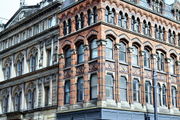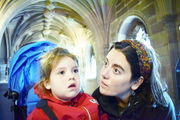Contents |
Manchester
Manchester est d'humeur triste
Et Liverpool vient pleurer sur la mer
Je ne sais plus si j'existe
Les bateaux blancs craignent l'hiver
Manchester is a city in the north of England, nearby Liverpool, at the intersection of Lancashire and Cheshire.

One of the highlights of Manchester—the Chetham's library—stores Robert Southey's Letters of Espriella in which he comments about Manchester that ‘a place more destitute of all interest is impossible to conceive’. The city does not seem indeed to make much of an impression on many, but it still has several claims of importance and historical relevance, starting with being the world's first big industrial city (with the textile manufacture). Today it remains a global city (where it is classified as β- while Birmingham for instance is only γ+). Its architecture is of varying quality and it is not the most pleasant city to walk around. It has some nice brick buildings, including the Midland hotel, an impressive Edwardian Baroque building, where Rolls & Royce met to form their company. It was also a favorite of Hitler who knew it for its architecture and this area of the town was allegedly spared bombing not to damage it. Still, Manchester seems to exacerbate urban loneliness melancholy. A Frenchman artist, Valette, who for unknown reasons found himself living in Manchester, painted the city with impressionist strokes that capture this atmosphere in a way that not even the museum can conceal. In the description of York Street Leading to Charles Street (see also below), the explicative panel reads: Valette has made the train very small. The resulting distortion of scale adds to the feeling that city life weighs heavily upon the foreground figures.
We visited it in April (2018) (Fabrice did pass by once in 2017 in a failed attempt to get a Chinese visa; on our second visit, which was with Camilo, he also tried to get a Chinese visa, and also failed).
Things to do/see
- Chetham's Library (Mon)
 30 April 2018
30 April 2018
- Castlefield park (canals and Roman amphitheatre)
 29 April 2018
29 April 2018
- Manchester Art Gallery
 29 April 2018
29 April 2018
- Manchester Cathedral
 30 April 2018
30 April 2018
- The John Rylands Library
 29 April 2018
29 April 2018
- Town hall
 only saw outside, closed for refurbishment
only saw outside, closed for refurbishment
- Victoria baths
- People's History Museum
 30 April 2018
30 April 2018
- A beer at the Old Wellington
 30 April 2018
30 April 2018
- St. Mary's Church
- Whitworth
- Heaton Park (far)
Chetham's Library
Chetham's Library might be the most important spot of Manchester. Founded 1653 in a 1421 building, is the oldest public library in the English-speaking world. It holds over 120000 volumes of printed books an other documents. Unlike the time of Chetham, would instructed ‘to require nothing of any man that cometh into the library’, its visit is today strictly regulated.

Marx and Engels used to meet there, in the window seat that you see on the left in this picture above, where they developed the Communist Manifesto. In a letter to Marx, Engels remember:
- During the last few days I have again spent a good deal of time sitting at the four-sided desk in the alcove where we sat together twenty-four years ago. I am very fond of the place. The stained glass window ensures that the weather is always fine there.
The stained glass is gone but the rest stayed there. The guide also mentioned a meeting of Cromwell on the roundtable, but I could find no other mention of that.
Gallery
In this area you can feel the proximity to Liverpool.
It has exceptional pieces such as the St John's fragment of the Bible (Papyrus P52).
Jesus taking all the space.
The Old Wellington, oldest pub in town, by the Mitre, our hotel in Manchester.
In one of the less famous libraries: the Portico (private collection).
Manchester Art Gallery
Manchester's Art gallery hosts several works of international significance. I discovered there Joseph Farquharson whose work with light made him an instant favorite painters of mine, along with Kuindzhi.
Marshall Ney at Retreat in Russia, a masterpiece of Adolphe Yvon who specialised in Napoleonic battles.
Julia with Turner's Now for the Painters (a painter is the rope to secure the boat as passengers (dis)embark).
The Water of the Nile from Frederick Goodall, who specialized in Egyptian themes.
Admiring The Chase from Richard Ansdell, who specialized in animals and genre scenes. On the right, Farquharson's masterpiece.
When the West with Evening Glows from Joseph Farquharson, who specialized in snowy winter landscapes.
Hylas and the Nymphs from Waterhouse was back when we visited the gallery [1].
Camilo trying to feel what it's like to be Henry Moore's Mount's Bay: Early Morning – Summer
Views of Manchester: Oxford road (right), India house (center) and York Street Leading to Charles Street (right) from Pierre Adolphe Valette, who specialized in urban landscapes of Manchester.
































